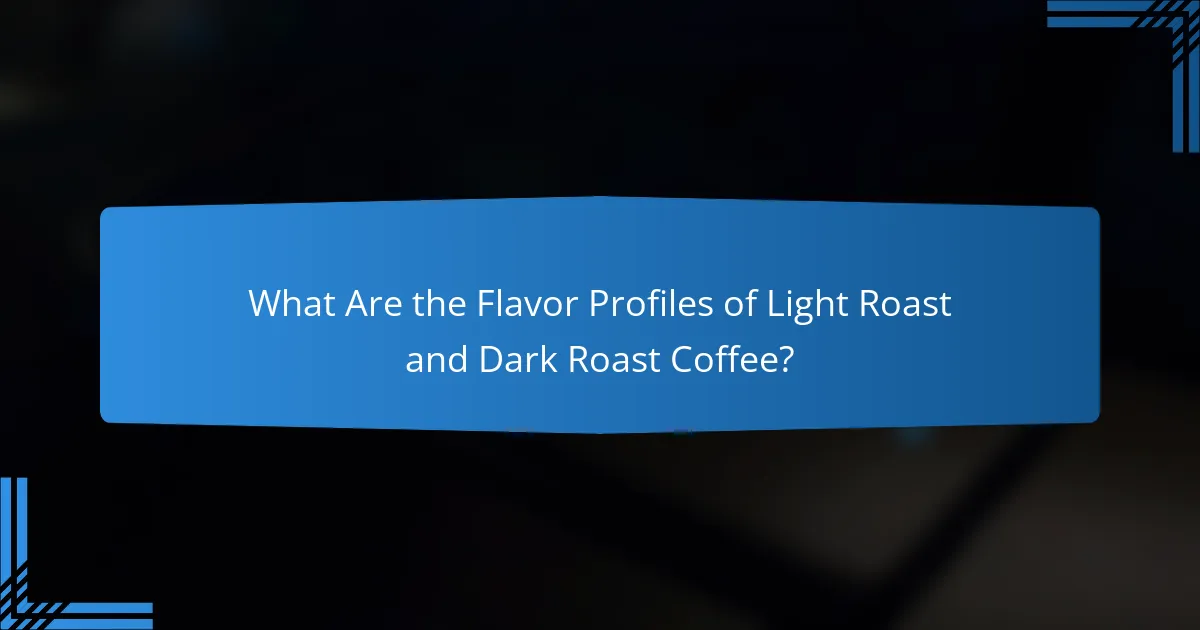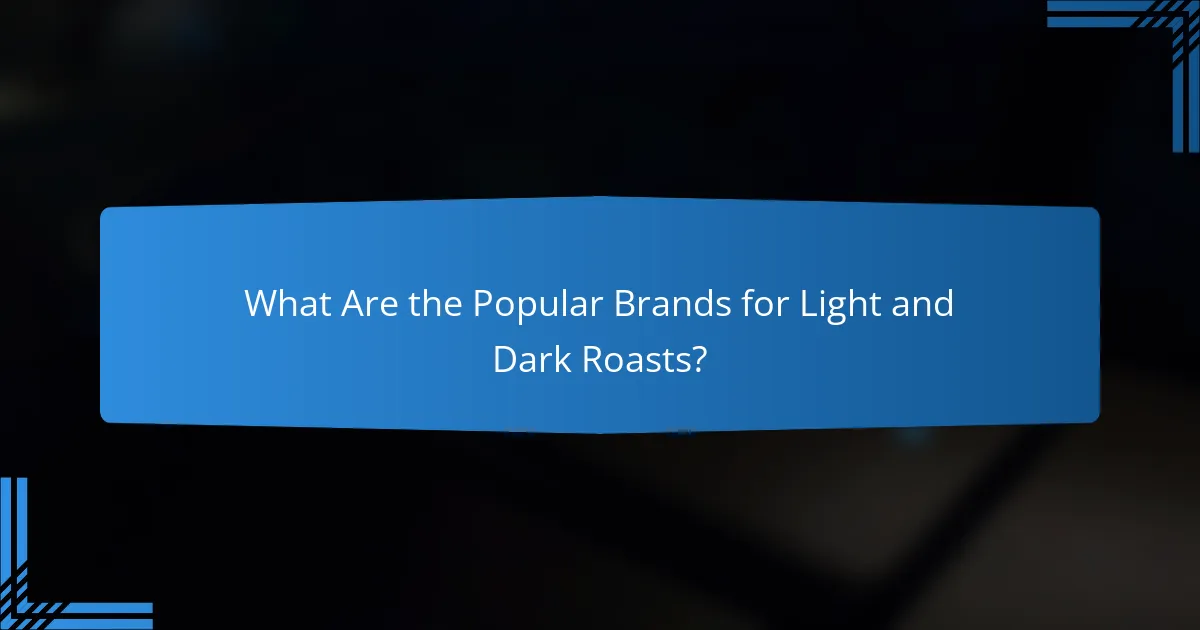Light roast and dark roast coffees present unique flavor profiles that cater to various taste preferences. While light roasts accentuate the inherent qualities of the beans, dark roasts deliver a more intense and robust flavor, shaped by the roasting process. Additionally, these roasts differ in caffeine content and optimal brewing methods, further influencing the coffee experience.

What Are the Flavor Profiles of Light Roast and Dark Roast Coffee?
Light roast and dark roast coffees offer distinct flavor profiles that appeal to different preferences. Light roasts tend to highlight the natural characteristics of the coffee beans, while dark roasts emphasize the roasting process, resulting in bolder, richer flavors.
Light Roast Flavor Characteristics
Light roast coffees are known for their bright acidity and pronounced fruity or floral notes. These roasts retain more of the beans’ original flavors, often showcasing citrus, berry, or herbal undertones. The body is typically lighter, making them refreshing and vibrant.
Common flavor descriptors for light roasts include lemon, green apple, and jasmine. They often have a sweet finish, which can be enhanced by brewing methods like pour-over or Aeropress that accentuate these delicate flavors.
Dark Roast Flavor Characteristics
Dark roast coffees are characterized by their deep, rich flavors and lower acidity. The roasting process brings out bold notes of chocolate, caramel, and sometimes smoky undertones. The body is fuller, providing a heavier mouthfeel that many coffee drinkers enjoy.
Flavor notes for dark roasts can include dark chocolate, molasses, and toasted nuts. These roasts are often preferred in espresso blends, where the intensity complements milk-based drinks like lattes and cappuccinos.
Comparative Flavor Notes
When comparing light and dark roasts, the primary difference lies in acidity and flavor complexity. Light roasts are often more nuanced and bright, while dark roasts deliver a straightforward, robust flavor profile. This contrast can influence brewing choices and food pairings.
For instance, light roasts pair well with lighter foods such as salads and seafood, while dark roasts complement richer dishes like chocolate desserts or hearty meats. Understanding these profiles can help coffee enthusiasts choose the right roast for their taste and occasion.

How Do Light Roast and Dark Roast Affect Caffeine Levels?
Light roast and dark roast coffees have different caffeine levels, with light roasts generally containing slightly more caffeine by volume. This difference arises from the roasting process, which affects the beans’ density and chemical composition.
Caffeine Content in Light Roast
Light roast coffee typically has a higher caffeine content compared to dark roast when measured by weight. The beans are roasted for a shorter time, preserving more of their natural caffeine. On average, a standard 8-ounce cup of light roast may contain around 95 to 200 milligrams of caffeine.
For those seeking a more pronounced caffeine kick, light roasts are often the preferred choice. The flavor profile is also brighter and more acidic, which can enhance the perception of caffeine’s stimulating effects.
Caffeine Content in Dark Roast
Dark roast coffee usually has slightly less caffeine than light roast when measured by volume, as the longer roasting process reduces the caffeine content. An 8-ounce cup of dark roast typically contains about 85 to 180 milligrams of caffeine. The beans lose moisture and density during roasting, which can lead to a lower caffeine concentration.
Despite this, many people enjoy dark roasts for their rich, bold flavors, which can sometimes mask the caffeine’s stimulating properties. The taste is often described as smooth and less acidic compared to light roasts.
Myths About Caffeine Levels
A common myth is that dark roast coffee has more caffeine than light roast due to its stronger flavor. In reality, the roasting process diminishes caffeine content in dark roasts. Additionally, many people mistakenly believe that the darker the roast, the more caffeine it contains.
Another misconception is that brewing methods significantly alter caffeine levels. While brewing time and temperature can affect extraction, the roast level remains the primary factor influencing caffeine content. For accurate caffeine intake, consider both the type of roast and the brewing method used.

What Are the Best Brewing Methods for Each Roast?
The best brewing methods for light and dark roast coffee vary significantly due to their distinct flavor profiles. Light roasts benefit from methods that highlight their acidity and brightness, while dark roasts thrive in techniques that enhance their boldness and richness.
Brewing Light Roast Coffee
To brew light roast coffee effectively, consider using methods like pour-over or Aeropress. These techniques allow for precise control over water temperature and extraction time, which are crucial for bringing out the delicate flavors and fruity notes typical of light roasts.
For optimal results, use water heated to around 90-96°C (194-205°F) and aim for a brew time of about 2-3 minutes. This helps maintain the coffee’s vibrant acidity and complex flavor profile.
Brewing Dark Roast Coffee
Dark roast coffee is best brewed using methods such as French press or espresso, which can handle the bold flavors and fuller body. These methods extract the deeper, chocolatey notes and reduce the brightness that can be overwhelming in darker beans.
For dark roasts, use water at a slightly higher temperature, around 92-98°C (197-208°F), and a brew time of about 4-5 minutes for methods like French press. This allows the oils and rich flavors to fully develop without over-extraction.
Recommended Equipment for Each Roast
For light roasts, a pour-over dripper or an Aeropress is recommended, as these tools provide control over the brewing process. A good burr grinder is essential to achieve a consistent grind size, which is crucial for flavor extraction.
For dark roasts, consider investing in a French press or an espresso machine. These devices can enhance the rich, bold flavors typical of dark roasts. A sturdy grinder that can handle coarser grinds is also beneficial for brewing methods like French press.

How Do Light and Dark Roasts Impact Health?
Light and dark roasts can influence health in various ways, primarily through their caffeine content and antioxidant levels. Light roasts generally retain more antioxidants, while dark roasts may have higher caffeine levels, affecting overall health benefits and risks.
Health Benefits of Light Roast
Light roast coffee is known for its higher antioxidant content, which can help combat oxidative stress in the body. These antioxidants, such as chlorogenic acids, may contribute to reduced inflammation and improved cardiovascular health.
Additionally, light roasts typically contain more caffeine than their dark counterparts, which can enhance mental alertness and focus. This can be particularly beneficial for those looking to boost productivity without the jitters associated with excessive caffeine intake.
Health Benefits of Dark Roast
Dark roast coffee is often easier on the stomach due to its lower acidity, making it a preferred choice for individuals with acid sensitivity. This can lead to a more enjoyable coffee experience without the discomfort of heartburn or acid reflux.
Moreover, dark roasts may contain compounds that promote digestive health. The roasting process breaks down certain compounds, making it easier for the body to absorb nutrients and potentially aiding in digestion.
Comparative Health Risks
While both light and dark roasts have health benefits, they also come with risks. Light roasts may lead to higher caffeine consumption, which can cause anxiety or sleep disturbances if consumed in excess. It’s advisable to monitor intake, especially for those sensitive to caffeine.
On the other hand, dark roasts, while lower in acidity, can still contribute to increased cholesterol levels due to certain oils released during the roasting process. Individuals with cholesterol concerns should consider limiting their intake of dark roast coffee.

What Are the Popular Brands for Light and Dark Roasts?
Popular brands for light and dark roasts vary significantly in flavor profiles and brewing preferences. Light roasts tend to highlight the coffee’s origin characteristics, while dark roasts offer a bolder, richer taste. Here are some notable brands in each category.
Top Light Roast Brands
Some of the leading brands for light roasts include Stumptown Coffee Roasters, Intelligentsia Coffee, and Blue Bottle Coffee. These brands focus on sourcing high-quality beans and often emphasize single-origin varieties that showcase unique flavor notes.
Stumptown, for example, is known for its fruity and floral profiles, while Intelligentsia often features bright acidity and complex flavors. Blue Bottle is celebrated for its meticulous roasting process that preserves the beans’ natural characteristics.
Top Dark Roast Brands
Popular brands for dark roasts include Peet’s Coffee, Starbucks, and Lavazza. These brands typically offer blends that emphasize deep, robust flavors and a fuller body. Peet’s Coffee is particularly known for its rich, smoky notes, while Starbucks offers a range of dark roasts that appeal to a wide audience.
Lavazza, an Italian brand, provides a smooth, chocolatey flavor profile that is popular in espresso blends. Each of these brands has developed a loyal following due to their distinctive approaches to dark roasting.
Brand Comparisons
When comparing light and dark roast brands, consider flavor profiles, sourcing practices, and roasting techniques. Light roasts often have higher acidity and more pronounced fruity or floral notes, while dark roasts provide a more intense, bitter flavor with chocolate or caramel undertones.
For instance, Stumptown’s light roast may appeal to those who enjoy bright, nuanced flavors, whereas Peet’s dark roast might attract drinkers looking for a bold, comforting cup. Additionally, consider the brewing method; light roasts are often best enjoyed as pour-overs, while dark roasts can excel in espresso preparations.

How to Choose Between Light Roast and Dark Roast for Your Taste?
Choosing between light roast and dark roast coffee depends on your flavor preferences and desired coffee experience. Light roasts tend to highlight the bean’s origin and acidity, while dark roasts offer a bolder, more robust flavor profile with deeper notes.
Factors to Consider in Flavor Preference
When selecting between light and dark roasts, consider the acidity, sweetness, and body of the coffee. Light roasts typically have a higher acidity and a lighter body, making them bright and fruity. Dark roasts, in contrast, have lower acidity and a fuller body, often featuring chocolatey or smoky flavors.
Another factor is the roasting process; light roasts undergo less time and heat, preserving more of the bean’s natural characteristics. Dark roasts are roasted longer, which can mask some of the bean’s unique flavors but enhance bitterness and richness.
Personal Taste Profiles
Your individual taste preferences play a crucial role in choosing between light and dark roasts. If you enjoy floral or fruity notes, light roasts may be more appealing. Conversely, if you prefer bold, rich flavors with a hint of bitterness, dark roasts are likely your best bet.
Consider experimenting with different brewing methods as well, as they can influence the final flavor. For example, pour-over methods may enhance the brightness of a light roast, while espresso can bring out the depth of a dark roast.
Subscription Services for Coffee Roasts
Many coffee subscription services allow you to explore both light and dark roasts, helping you refine your preferences over time. These services often curate selections based on your taste profile, providing a convenient way to discover new flavors.
Look for subscriptions that offer flexibility in roast types, allowing you to switch between light and dark roasts based on your mood or seasonal preferences. Some popular services even provide tasting notes and brewing tips to enhance your coffee experience.
